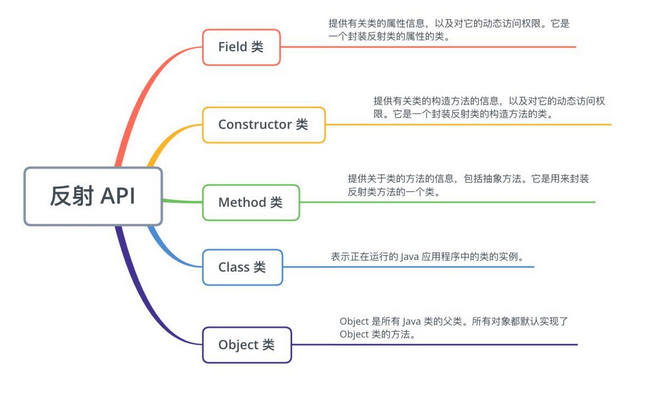public class ReflectUtils extends ReflectionUtils {
/**
* 获取类属性(包含私有以及受保护的,父类也会检索)
*
* @param sourceClass 类
* @param fieldName 属性名称
* @return 属性
*/
public static Field getField(Class<?> sourceClass, String fieldName) {
Field field = null;
try {
field = sourceClass.getField(fieldName);
} catch (NoSuchFieldException ignored) {
}
if (field == null) {
try {
field = sourceClass.getDeclaredField(fieldName);
} catch (NoSuchFieldException ignored) {
}
}
if (field == null) {
Class<?> superClass = sourceClass.getSuperclass();
if (superClass != null) {
field = getField(superClass, fieldName);
}
}
return field;
}
/**
* 获取属性的值
*
* @param object 对象
* @param fieldName 属性名
* @return 属性值
*/
public static Object getFieldValue(Object object, String fieldName) {
Object value = null;
if (object != null) {
Field field = getField(object.getClass(), fieldName);
if (field != null) {
field.setAccessible(true);
try {
value = field.get(object);
} catch (IllegalAccessException e) {
e.printStackTrace();
}
} else {
System.err.println("Field is not exist");
}
}
return value;
}
/**
* 获取静态属性值
*
* @param sourceClass 类
* @param fieldName 属性名
* @return 属性值
*/
public static Object getStaticFieldValue(Class<?> sourceClass, String fieldName) {
Field field = getField(sourceClass, fieldName);
Object value = null;
if (field != null) {
field.setAccessible(true);
if (isStatic(field)) {
try {
value = field.get(null);
} catch (IllegalAccessException e) {
e.printStackTrace();
}
} else {
System.err.println("Field is not static");
}
} else {
System.err.println("Field is not exist");
}
return value;
}
/**
* 设置属性值
*
* @param object 对象
* @param fieldName 属性名
* @param newValue 新值
*/
public static void setFieldValue(Object object, String fieldName, Object newValue) {
if (object != null) {
Field field = getField(object.getClass(), fieldName);
if (field != null) {
field.setAccessible(true);
if (!isFinal(field)) {
try {
field.set(object, newValue);
} catch (IllegalAccessException e) {
e.printStackTrace();
}
} else {
System.err.println("Field is final");
}
} else {
System.err.println("Field is not exist");
}
}
}
/**
* 设置静态属性值
*
* @param sourceClass 类
* @param fieldName 属性名
* @param newValue 新值
*/
public static void setStaticFieldValue(Class<?> sourceClass, String fieldName, Object newValue) {
Field field = getField(sourceClass, fieldName);
if (field != null) {
field.setAccessible(true);
if (isStatic(field)) {
if (!isFinal(field)) {
try {
field.set(null, newValue);
} catch (IllegalAccessException e) {
e.printStackTrace();
}
} else {
System.err.println("Field is final");
}
} else {
System.err.println("Field is not static");
}
} else {
System.err.println("Field is not exist");
}
}
/**
* 是否静态(方法、属性。。。)
*
* @param field 要判断的对象
* @return 是否
*/
public static boolean isStatic(Object field) {
return java.lang.reflect.Modifier.isStatic((Integer) invokeMethod(field, "getModifiers", null));
}
/**
* 是否不可变/覆写(方法、属性。。。)
*
* @param field 要判断的对象
* @return 是否
*/
public static boolean isFinal(Object field) {
return java.lang.reflect.Modifier.isFinal((Integer) invokeMethod(field, "getModifiers", null));
}
/**
* 是否公共(方法、属性。。。)
*
* @param field 要判断的对象
* @return 是否
*/
public static boolean isPublic(Object field) {
return java.lang.reflect.Modifier.isPublic((Integer) invokeMethod(field, "getModifiers", null));
}
/**
* 是否私有(方法、属性。。。)
*
* @param field 要判断的对象
* @return 是否
*/
public static boolean isPrivate(Object field) {
return java.lang.reflect.Modifier.isPrivate((Integer) invokeMethod(field, "getModifiers", null));
}
/**
* 是否受保护(方法、属性。。。)
*
* @param field 要判断的对象
* @return 是否
*/
public static boolean isProtected(Object field) {
return java.lang.reflect.Modifier.isProtected((Integer) invokeMethod(field, "getModifiers", null));
}
/**
* 获取类方法(包含私有以及受保护的,父类也会检索)
*
* @param sourceClass 类
* @param methodName 方法名
* @param var2 方法的参数类型
* @return 方法对象
*/
public static Method getMethod(Class<?> sourceClass, String methodName, Class... var2) {
Method method = null;
try {
method = sourceClass.getMethod(methodName, var2);
} catch (NoSuchMethodException ignored) {
}
if (method == null) {
try {
method = sourceClass.getDeclaredMethod(methodName, var2);
} catch (NoSuchMethodException ignored) {
}
}
if (method == null) {
Class<?> superClass = sourceClass.getSuperclass();
if (superClass != null) {
method = getMethod(superClass, methodName, var2);
}
}
return method;
}
/**
* 执行静态方法
*
* @param sourceClass 类
* @param methodName 方法名
* @param var2 参数
* @return 执行结果
*/
public static Object invokeStaticMethod(Class<?> sourceClass, String methodName, Object... var2) {
Class<?>[] args = null;
if (var2 != null) {
args = new Class[var2.length];
for (int i = 0; i < var2.length; i++) {
args[i] = var2[i].getClass();
}
}
Method method = getMethod(sourceClass, methodName, args);
Object result = null;
try {
if (method != null) {
if (isStatic(method)) {
method.setAccessible(true);
result = method.invoke(null, var2);
} else {
System.err.println("method is not static");
}
} else {
System.err.println("Method is not exist");
}
} catch (IllegalAccessException e) {
e.printStackTrace();
} catch (InvocationTargetException e) {
e.printStackTrace();
}
return result;
}
/**
* 执行类方法
*
* @param sourceObject 类对象
* @param methodName 方法名
* @param var2 参数
* @return 执行结果
*/
public static Object invokeMethod(Object sourceObject, String methodName, Object... var2) {
Class<?>[] args = null;
if (var2 != null) {
args = new Class[var2.length];
for (int i = 0; i < var2.length; i++) {
args[i] = var2[i].getClass();
}
}
Method method = getMethod(sourceObject.getClass(), methodName, args);
Object result = null;
try {
if (method != null) {
method.setAccessible(true);
result = method.invoke(sourceObject, var2);
} else {
System.err.println("Method is not exist");
}
} catch (IllegalAccessException e) {
e.printStackTrace();
} catch (InvocationTargetException e) {
e.printStackTrace();
}
return result;
}
}


